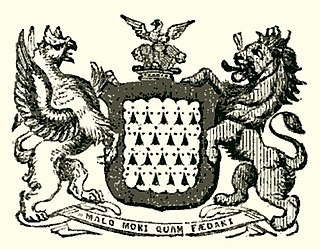
Viscount Hawarden is a title in the Peerage of Ireland.

The title Baron of Dunsany or, more commonly, Lord Dunsany, is one of the oldest dignities in the Peerage of Ireland, one of just a handful of 13th- to 15th-century titles still extant, having had 21 holders, of the Plunkett name, to date. Other surviving medieval baronies include Kerry, Kingsale, Trimlestown (1469), Baron Louth, and Dunboyne.

Rowland FitzEustace, 1st Baron Portlester was an Irish peer, statesman and judge. He was one of the dominant political figures in late fifteenth-century Ireland, rivalled in influence probably only by his son-in-law Garret FitzGerald, the "Great" Earl of Kildare.
Earl of Fingall and Baron of Killeen were titles in the Peerage of Ireland, the latter one of the earliest surviving, while Baron Fingall was a title in the Peerage of the United Kingdom. The seat of the title-holders was, from the 1400s until 1953, Killeen Castle in County Meath, Ireland, and there was an ongoing close relationship with the related Plunkett family of Dunsany, and with the Viscounts Gormanston, with whom they intermarried.
Christopher Plunkett, 1st Baron of Dunsany was an Anglo-Norman peer. He was the second son of Sir Christopher Plunkett and Genet de Cusack.
The Recorder of Dublin was a judicial office holder in pre-Independence Ireland.
Thomas Eustace, 1st Viscount Baltinglass was an Anglo-Irish noble who achieved wealth and influence by prudently remaining loyal to the English Crown. He was born circa 1480 at Caslemartin, County Kildare.

John Barnewall, 3rd Baron Trimleston, was an Irish nobleman, judge and politician. He was the eldest son of Christopher Barnewall, 2nd Baron Trimlestown and his wife Elizabeth Plunket, daughter of Sir Thomas Fitz-Christopher Plunket of Rathmore, Lord Chief Justice of the King's Bench in Ireland and his second wife Marian Cruise. He succeeded his father as 3rd Baron in about 1513. His father, like most of the Anglo-Irish aristocracy, had supported the claim of the pretender Lambert Simnel to the English throne in 1487. After the failure of Simnel's rebellion, he received a royal pardon.

Sir Richard Edgcumbe of Cotehele in the parish of Calstock in Cornwall, was an English courtier and Member of Parliament.
Robert Preston, 1st Viscount Gormanston (1435–1503) was an Irish peer and statesman of the fifteenth century who held the offices of Deputy to the Lord Chancellor of Ireland and Lord Deputy of Ireland.
Sir Robert FitzEustace (c.1420–1486) was an Irish landowner and politician of the fifteenth century.
Robert Plunkett, 5th Baron Dunsany was an Anglo-Irish nobleman of the Tudor period.
Edward Plunkett, 4th Baron of Dunsany was an Irish nobleman; he was killed in battle during the Irish Rebellion of 1520–1.
Sir William Darcy (c.1460–1540) was a leading Anglo-Irish statesman of the Pale in the early sixteenth century; for many years he held the office of Vice-Treasurer of Ireland. He wrote an influential treatise, The Decay of Ireland, which led to his being called "the father of the movement for political reformation in Ireland". He was a colourful and flamboyant character, whose exceptional height gave rise to his nickname "Great Darcy".

Gerald FitzGerald, 8th Earl of Kildare, known variously as "Garret the Great" or "The Great Earl", was Ireland's premier peer. He served as Lord Deputy of Ireland from 1477 to 1494, and from 1496 onward. His power was so great that he was called "the uncrowned King of Ireland".
The Brotherhood of Saint George was a short-lived military guild, which was founded in Dublin in 1474 for the defence of the English-held territory of the Pale. For a short time, it was the only standing army maintained by the English Crown in Ireland. It was suppressed by King Henry VII in 1494, due to his suspicions about the Brotherhood's loyalty to his dynasty. It was not an order of knighthood, although some of its individual members were knights.
Sir Thomas Plunket (c.1440–1519) was a wealthy Irish landowner, lawyer and judge in fifteenth-century and early sixteenth-century Ireland. He held office as Chief Baron of the Irish Exchequer and Chief Justice of the Irish Common Pleas. After the change of the English royal family in 1485, his loyalty to the new Tudor dynasty was deeply suspect, and he was involved in two attempts to put a pretender on the English throne. On each occasion he was disgraced, fined and removed from office; yet he had sufficient political influence to ensure his return to favour and high office.
Thomas Cusacke, Cusack or de Cusack was an Irish barrister and judge, who held the offices of Attorney General for Ireland and Lord Chief Justice of Ireland. He should not be confused with his much younger cousin Sir Thomas Cusack, Lord Chancellor of Ireland, who was a child of about six when the elder Thomas died.
John Nangle, 16th Baron of Navan was an Irish nobleman and military commander of the early Tudor era. He was renowned in his own lifetime as a courageous soldier, who fought with distinction at the Battle of Knockdoe in 1504.
Richard Plunkett, 2nd Baron of Dunsany was an Irish nobleman. He was one of at least five surviving sons of Christopher Plunkett, 1st Baron of Dunsany, and his first wife Anne Fitzgerald, daughter of Richard FitzGerald. He succeeded to the title in 1462.






